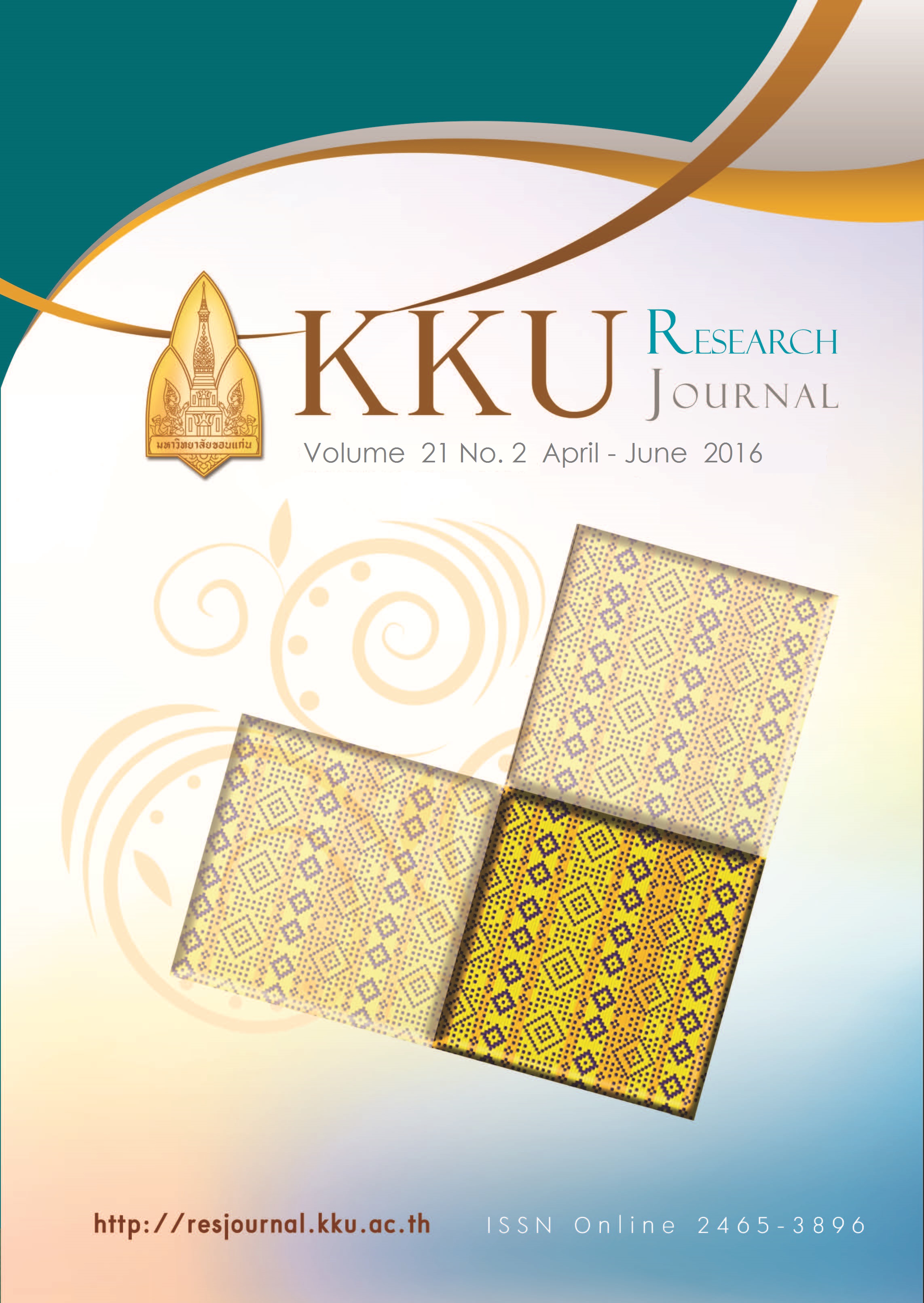Comparison of biogenic amine concentrations in fermented fish with and without maize seedling extract
Main Article Content
Abstract
Biogenic amines (BAs) are low molecular weight organic bases with aliphatic, aromatic, and heterocyclic structures. The formation of biogenic amines in food by the microbial decarboxylation of amino acids can result suffering allergic reactions, characterized by difficulty in breathing, itching, rash, vomiting, fever, and hypertension. Amine oxidase activity has become a particular interest to reduce biogenic amines concentration in food products such as Somfug or fermented fish. The aim of this study was to reduce biogenic amines accumulation during Somfug fermentation by maize seedling extract. Amine oxidase activity was measured by coupled reaction with peroxidase and guaiacol with putrescine as substrate at pH 7.5, 30 °C for 30 min. The amine oxidase activity of maize seedling extract was 27.54 U/ g fresh weight. The maize seedling extract of 10-24 ml was added in 100 g Somfug before fermentation. Amine oxidase activity of Somfug with maize seedling extract before fermentation was 5.50 U/ g Somfug. After 7 days of fermentation, total biogenic amines concentration was 83.04 % less in samples added with maize seedling extract, as compared to control samples. These results indicated that maize seedling extract with amines oxidase activity in Somfug fermentation was effective in reducing biogenic amines accumulation.
Article Details
References
[2] Halász A, Barath A, Simon-Sarkadi, Holzapfel W. Biogenic amines and their production by microorganisms in food. Trends Food Sci Technol. 1994; 5: 42–9.
[3] Scanlan RA. Formation and occurrence of nitrosamines in foods. Cancer Res. 1983; 43 (Supplementary): 2435–40.
[4] Flores M, Aristoy MC, Toldra F. Biogenic polyamines affect activity of aminopeptidase B and alanyl aminopeptidase from porcine skeletal muscle. J Food Sci. 1996; 61: 13–27.
[5] Cona A, Cenci F, Cervelli M, Federico R, Mariottini P, Moreno S, Angelini R. Polyamine oxidase, a hydrogen peroxide-producing enzyme, is up-regulated by light and down-regulated by auxin in the outer tissues of the maize mesocotyl. Plant Physiol. 2003; 131: 803–13.
[6] Yoda H, Yamaguchi Y, Sano H. Induction of hypersensitive cell death by hydrogen peroxide produced through polyamine degradation in tobacco plants. Plant Physiol. 2003; 132:1973–81.
[7] Bouchereau A, Aziz A, Larher F, Martin-Tanguy J. Polyamines and environmental challenges: recent development. Plant Sci. 1999; 140: 103–25.
[8] Smith TA. Recent advances in the biochemistry of plant amines. Phytochemistry. 1975; 14: 865–90.
[9] Yeunyongsuwan K, Kongkiattikajorn J. Study of amine oxidases from cereal seedlings and local plants. Proceedings of 43rd Kasetsart University Annual Conference: Veterinary Medicine, Science. 2005; 522–9.
[10] Kalač P, Špička J, Křižek M, Pelikanova T. The effect of lactic acid bacteria inoculants on biogenic amines formation in sauerkraut. Food Chem. 2000; 70: 355–9.
[11] Zaman MZ, Abu Bakar F, Jinap S,Bakar J. Novel starter cultures to i n h i b i t b i o g e n i c a m i n e s
accumulation during fish sauce fermentation. Int J Food Microbiol. 2011; 145: 84–91.
[12] Eerola S, Hinkkanen R, Lindfors E, Hirvi T. Liquid chromatographic determination of biogenic amines in dry sausages. J AOAC Int. 1994; 76: 575–7.
[13] Tsai YH, Lin CY, Chang SC, Chen HC, Kung HF, Wei CI, Hwang DF. Occurrence of histamine and histamine forming bacteria in salted mackerel in Taiwan. Food Microbiol. 2005; 22: 461–7.
[14] Tsai YH, Lin CY, Chien LT, Lee TM, Wei C I, Hwang DF. Histamine contents of fermented fish products in Taiwan and isolation of histamine forming bacteria. Food Chem. 2006; 98: 64–70.
[15] Mah JH, Chang YH, Hwang HJ. Paenibacillus tyraminigenes sp. nov. isolated from Myeolchijeotgal, a traditional Korean salted and fermented anchovy. Int J Food Microbiol. 2008; 127: 209–14.
[16] Coton E, Coton M. Evidence of horizontal transfer as origin of strain to strain variation of the tyramine production trait in Lactobacillus brevis. Food Microbiol. 2009; 26: 52-7.
[17] V e c i a n a - N o g u e s M T , Albala-Hurtado S, Marine-Font, Vidal-Carou MC. Changes in biogenic amines during the manufacture and storage of semipreserved anchovies. J Food Prot. 1996; 59 (11): 1218–1222.
[18] Luten JB, Bouquet W, Seuren LAJ, Burggraaf MM, Riekwel-Booy G, Durand P, Etienne, M, Gouyou JP, Landrein A, Ritchie A, Leclerq M, Guinet R. Biogenic amines in fishery products: standardization methods within E. C. In Huss, H.H.
(Ed.) Quality Assurance in the Fish Industry, Elsevier Science Publishers. Amsterdam. 1992. P. 427– 39.


